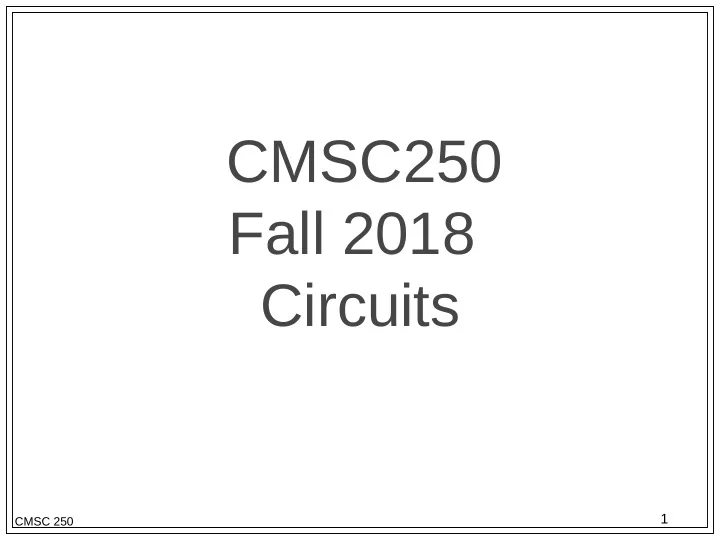

CMSC250 Fall 2018 Circuits 1 CMSC 250
Logic == Math? What calculations can we do with logic? Add, subtract, multiply? George Boole – 1800’s. Boolean logic Claude Shannon – 1937. Logic == circuits == math T = 1 p v q == p+q p v ~q F = 0 p ^ q == p*q is ~ p == (1-q) p + (1-q) 2 CMSC 250
Find Boolean formula for: p, q & r p q r output are the variables. 1 1 1 1 1 1 0 1 1 0 1 0 1 0 0 1 0 1 1 0 0 1 0 0 0 0 1 0 3 CMSC 250
Find Boolean Formula For each row with output 1 obtain “mini-formula” which is 1 exactly on that row. OR together all of the mini-formulas 111, 110, and 100 all output 1 p^q^r, p^q^~r, p^~q^~r (p^q^r) (p^q^~r) (p^~q^~r) 4 CMSC 250
Basic logic gates AND gate: OR gate: NOT gate: 5 CMSC 250
Basic logic gates AND gate: OR gate: NOT gate: 6 CMSC 250
Circuit to Boolean formula Given this circuit, convert to logic 7 CMSC 250
Circuit to Boolean formula Given this circuit, convert to logic p v ~(p ^ r) 8 CMSC 250
Draw a circuit for: p, q & r p q r output are inputs. Simplify 1 1 1 1 before building 1 1 0 1 the circuit. 1 0 1 0 1 0 0 1 0 1 1 0 0 1 0 0 0 0 1 0 9 CMSC 250
Number conversions Different number system bases are used when convenient – some commonly-used bases are 10 (decimal), 2 (binary), 8 (octal), 16 (hexadecimal) – the base tells how many different numerals are used – the base also determines the value of each place Conversions from anything to base 10 – use the definition of the number system Conversions from base 10 to anything – use repeated integer division 10 CMSC 250
Addition of binary numbers Carry if the number would be too large for the number system- if it is greater than 1 1001 1001 1011 1101 + 10 + 11 + 10 + 111 1011 1100 1101 10100 11 CMSC 250
Addition of octal and hexadecimal numbers Carry if the number would be too large for the number system (larger than 7 or 15) 723 8 265 8 ABC 16 CDE 16 + 12 8 + 33 8 + 12 16 + ED 16 735 8 320 8 ACE 16 DCB 16 12 CMSC 250
Two's complement To represent negative values in binary: 1. Find the binary equivalent of the absolute value. 2. Pad on the left to completely fill the bits in the specified bit width 3. Switch all of the 1's to 0's and 0's to 1's. 4. Add 1 to the result. • Example: find the 8-bit two's complement representation of -43: 1. 43 10 = 101011 2 2. 00101011 2 3. 11010100 2 4. 11010101 2 = -43 10 13 CMSC 250
Using a circuit for adding two bits input output Write as a logic p q carry sum expression 0 0 0 0 Translate to circuits 0 1 0 1 1 0 0 1 1 1 1 0 14 CMSC 250
Half adder Sum = (x v y) ^ ~ (x ^ y) Carry = (x ^ y) 15 CMSC 250
Full adder Three bits in (x, y, previous carry) 16 CMSC 250
Parallel adders • Chain these half adders and full adders together for multi-bit addition • A 3 A 2 A 1 A 0 + B 3 B 2 B 1 B 0 = S 3 S 2 S 1 S 0 X 3 Y 3 X 2 Y 2 X 1 Y 1 17 CMSC 250
Topic not covered Simplifying circuits: there are techniques that exist (which are complex). 18 CMSC 250
Recommend
More recommend